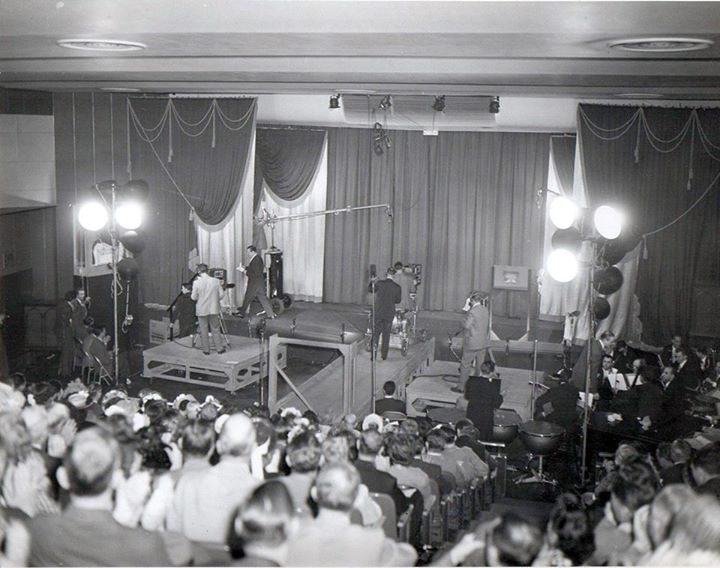

SPECIAL NBC NY STUDIOS HISTORY…FIRST HAND ACCOUNT
SPECIAL NBC NY STUDIOS HISTORY…FIRST HAND ACCOUNT
This article includes A MUST READ, FIRST HAND ACCOUNT from one of NBC’s veteran cameramen, Frank Vierling. His story starts 68 years ago today, on his first day, January 6, 1949, and gives us details of the little known NBC mobile camera units used INSIDE 30 Rockefeller Plaza, in studios that were still radio studios!
The Birth and Rebirth of Studio 3A
By Frank Vierling, with thanks to Joel Spector
I was hired and reported for work on January 6, 1949. All new engineering hires had to pass through Whitney Baston’s studio audio operations class. I was assigned to Kinescope Recording, for about a month, waiting for a new class opening. Following Mr. Baston’s class I worked a few studio shows before being assigned to the TV Field group where the mobile units were, garaged in Long Island City.
Field had two mobile units, each equipped with three camera chains. Unit 1A’s gear was color coded blue and Unit 1B’s was Yellow. (These units covered sports, but were mostly used to televise shows from the theaters NBC was acquiring, but had not yet equipped permanently).
A third set of cameras (the Green Gear) was stored in Rock Center and moved to different studios as programming required.
Only two studios, 8G and 3H had their own cameras. The Green Gear covered the NBC Symphony from 8H, Perry Como in 6A and Milton Berle in 6B, among others.
On a 1949 Saturday, still a member of TV Field, I was part of a crew assigned to work in NBC Studio 3B. We moved the Green Unit (in house) equipment to 3B and set up for Jon Gnagy’s show “You Are an Artist”. John hosted the very first “learn to draw” show on TV.
Following Gnagy, one camera was pushed across the hall into Studio 3A for “Story Book Time.” An actress, dressed in a Little Bow Peep costume, read and turned pages of a giant story book. (This was TV’s first use of 3A although technically it was just an extension of 3B.)
Before we broke for lunch, Leon Pearson did a noon news spot. While we were on our lunch break, Studio 3B was set up for the prime time “Phil Silver’s Arrow Shirt Show,” which was followed by a Pearson news spot at 11.
After the Pearson news spot, we moved the gear and set up Studio 6A for Sunday morning’s Horn & Hardart “Children’s Hour,” hosted by Ed Herlihy. With little sleep and short turnaround we were back in for the Sunday broadcast day. In addition to the “Children’s Hour,” we did “Leave It to the Girls,” with Maggi McNellis in 6B (cameras pushed across the hall). The cameras returned to 6A for the “The Meredith Wilson Show” and sign off news with Leon.
The Birth of TV in 3A.
Sometime in 1949 Field received three new camera chains. At first, it was thought they were to replace or add to our Field equipment. We soon found they were bound for studio 3A. The gear was coded RED. With the Red Gear, 3A became the third TV Studio. A variety of shows originated from 3A, a few I worked were “Morton Downey’s Mohawk Rug Show” and “The Roberta Quinlan Show”, the sitcom “Henry Aldrich” (“Coming Mother”), “Who Said That?” and “Date in Manhattan”. – Frank Vierling
Many thanks to Frank for capturing that great history and Joel Spector for sharing it. This photo shows the NBC Green Unit in use on one of the first “Texaco Star Theater” broadcasts from Studio 6B. Notice they lit the show with only a dozen scoops. The Green Unit’s camera control units were mounted on rolling carts and were always set up in the sound lock hallways of each studio.
The signals eventually wound up in Master Control, but just where the director, TD and switcher was is not known. I know that later, but still before TV control rooms were added, some TV people were in the radio control rooms of these studios. Perhaps they had a portable video board, or the signals went to the control rooms of either Studio 3H or 8G which were real TV studios. I’ll try to find out from Mr. Vierling, who’s in his 90s now. -Bobby Ellerbee
Interesting about the audio-operations class. One day, around thirty years ago, I walked into Barnes & Noble at the South Street Seaport…and walked out with the NBC Audio Production Training Manual from around 1945. I treasure it, along with the CBS NFL Manual from the 1960s. Shows how things were done in those days.
My dad and I knew Frank. Those were amazing days
What an amazing time in broadcasting. I really appreciate all you share,and Frank’s description was outstanding.
I see the tympani practically sitting in the audience. At WGN-TV’s Studio 1A, in 1953, there was no orchestra pit. So they put Bob Trendler’s orchestra in the audience (Trendler conducted from up on the stage) during the Army and Navy shows. I used to sit alongside the baritone saxophone. That’s how I learned basic musical counterpoint.
It seems logical that the camera units would move around, and be connected to one of the existing control rooms, 3H or 8G as available.
Man, they were doing TV with stone knives and bear skins back then.
Thank you for obtaining the historical “institutional knowledge” from Mr. Vierling.
I remember Frank Vierling. He “knew his stuff” inside and out….I recall having to drive Mobile Unit 1A from the Fairview, N.J. where the mobile units were later parked for many years. The steering radius on 1A was so minimal that navigating turns was crucial.